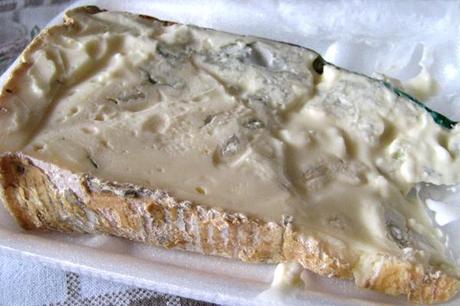
If you like blue cheese, but you haven't tried gorgonzola (
 ), you're going to love it. If you don't like blue cheese, and you try gorgonzola, you might very well start to like blue cheese! In fact, next to the traditional Gorgonzola Piccante (pungent), the milder Gorgonzola Dolce (sweet) meets the palate of those who are not too fond of 'blue' flavors.
), you're going to love it. If you don't like blue cheese, and you try gorgonzola, you might very well start to like blue cheese! In fact, next to the traditional Gorgonzola Piccante (pungent), the milder Gorgonzola Dolce (sweet) meets the palate of those who are not too fond of 'blue' flavors.The characteristic pungent aroma of Gorgonzola Piccante is due to the aromatic molds that, over a 6 month aging period, grow to fully inhabit it. As the cheese ages, it becomes compact or even crumbly because of its natural loss of moisture (down to 30-40%). This transformation also intensifies the flavor.

A slice of Gorgonzola Piccante
Gorgonzola Dolce instead (shown in the opening picture) is only aged 2 to 3 months: it has only partially established molds and still contains high amounts of moisture (45%). This results in a cheese that is only mildly blue, and that is also creamy and spreadable.
Both varieties of gorgonzola are made from whole cow milk, and they have similar percentages of fat (around 25-30%).
Cheese production makes use of specific kinds of molds (Penicillia) that over the centuries were discovered capable of improving the flavor and the texture of the product. We now know that these molds are aerobic fungi that produce enzymes capable of metabolizing the milk fats and proteins, therefore completely transforming the cheese. These molds are perfectly safe to eat since they don't release any toxins, and even have antibacterial properties. The antibiotic penicillin, in fact, derives from a mold that belongs to the same family.
Out of all of the different kinds of Penicillia, only two are responsible for the characteristic flavor of the countless varieties of blue cheese: Penicillium glaucum and Penicillium roqueforti. Gorgonzola is traditionally made using the former, but the latter can also be used.
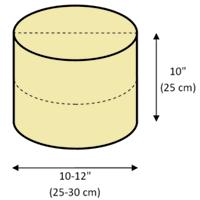
For easier distribution, a drum
of gorgonzola is generally cut
in 4 pieces.
Origins
The origins of gorgonzola are controversial, but they certainly revolve around the city that bears the same name: Gorgonzola, 15 km East of Milan, in the core of Lombardy.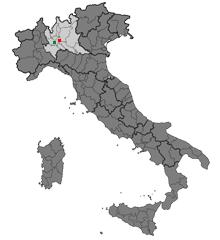
Milan (green dot) and Gorgonzola
(red dot) in the region Lombardy.
Over time, the production of gorgonzola expanded to other parts of Lombardy, but the city of Gorgonzola maintained its prestige until the middle of the 19th century. In 1840 writer Luigi Cattaneo wrote in his Milanese publication: Il Politecnico that "while the cheese makers of the town of Gorgonzola kept the secret of the peculiar circumstances that make this cheese special, this cheese remained their almost exclusive privilege. But nowadays this cheese is produced in several other locations in Lombardy with the same good success, although the one that is made in the surroundings of Gorgonzola maintains higher commercial regard."(2)
Since 1970, the production of gorgonzola is regulated by its Consortium, and it's limited to specific areas of Lombardy and Piedmont, as stipulated by its designation of Protected Geographical Status.
Uses
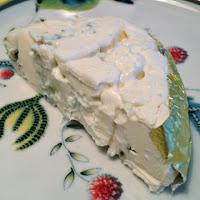
Gorgonzola and mascarpone "cake".
Gorgonzola is commonly eaten by itself, usually spread on bread. The aged variety (Gorgonzola Piccante) is eaten in smaller amounts, and sometimes paired with honey to counterbalance its intense flavor. For those who prefer more delicate flavors, a modern preparation exists that is even milder than Gorgonzola Dolce: a gorgonzola "cake" made by layering sweet gorgonzola with mascarpone.Gorgonzola is also widely used in cooking. The main examples see it used:
- as a sauce for pasta and gnocchi, sometimes with the addition of walnuts;
- in risotto, simply added when the rice is nearly cooked;
- on pizza, alone or as one of the 4 cheeses in Quattro Formaggi;
- with polenta, especially baked in layers.

Gnocchi with gorgonzola (left) and risotto with gorgonzola (right).
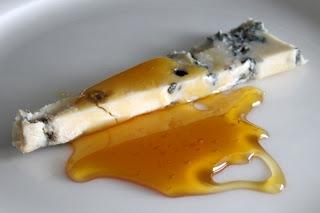
Gorgonzola Piccante with a teaspoon of chestnut honey.
The wine pairings of gorgonzola are somewhat difficult and a source of lengthy debates. There seems to be consensus however, that gorgonzola dolce goes with fruity wines (Riesling, Pinot bianco, various novelli). Gorgonzola Piccante instead needs a stronger, sweeter wine, even fortified: various kinds of passito, as well as Port and Marsala. All agree that gorgonzola goes well with beer, especially the Trappist kind.Notes
1) Stracchino is a fat cheese whose name derives from the word "stracco" ("tired" in Milanese dialect), in reference to the fact that it was made with the milk of cows that were "tired" because of having just returned to the valley after spending the summer on higher pastures.2) Luigi Cattaneo, On the way to produce the fat cheese called Stracchino of Gorgonzola, Il Politecnico 3 (1840), p. 309-322.

